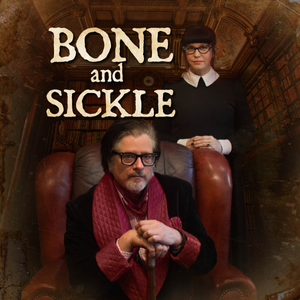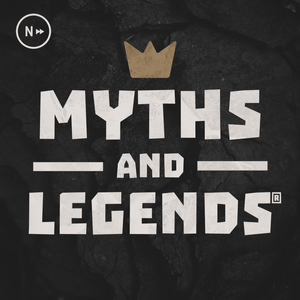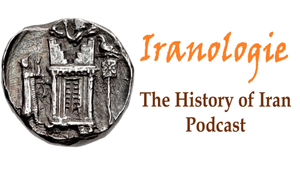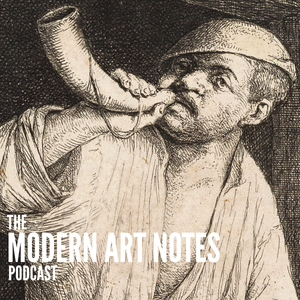
Holy Puppets, Medieval Robots, and More
05/08/20 • 47 min
This episode looks at puppets given life through magical or mechanical means, holy puppets of the Catholic Church, medieval robots, an early automata of gothic literature, some related films, and an Alpine sex puppet that only puts up with so much.
We begin at the end of Carolo Collodi’s original Pinocchio story, or at least the end of the story’s first draft as serialized by the Italian children’s magazine, Giornale per i bambini in 1881. As is our way, we examine some of the darker elements of the tale that never made it into the 1940 Disney film, (though we do hear a snippet of one particularly dark scene from that film.)
Pinocchio nearly fried in oil — from Collodi’s 1881 book.Long before Collodi imagined his marionette, the medieval Church made use of puppets, or jointed figures, that could be manipulated to enact Christ’s Passion during Easter week. Along with jointed shoulders allowing a figure of the Savior to be naturalistically unpinned from the cross, many of these puppets featured joints at the knees, elbows, and hips; some had rotating heads, and some fingers jointed to match each skeletal bone. Others were rigged to bleed, roll their eyes, or even appear to speak. We hear a report of a particularly bizarre method used to simulate tears in one figure from Germany as well as some interesting trickery resorted to by Bernese monks in the 1600s.
One of the most famous of these figures, especially because of its strangely lifelike skin, is the Christ of Burgos, Spain. Mrs. Karswell reads for us a passage mentioning a particularly gruesome legend associated with the figure from French poet and writer Théophile Gautier’s 1843 book, Wanderings in Spain.
Another famed Christ puppet was the 15th-century Rood of Grace once housed at a now ruined abbey in the town of Boxley in Kent. A number of miraculous abilities were attributed to this figure, which was attacked (literally) by Protestant Reformers as an example of Catholic chicanery. We hear of its unseemly end and an equally unseemly ballad by which Cromwell’s men mocked the figure in bawdy verse.
German Christ puppet, the “Miracle Man”Spain’s particularly rich heritage of mechanically animated holy figures owes much to Muslim innovations there. It was from here that geared devices such as astrolabes entered the West, and here that that weight-driven clocks were employed almost two centuries before their use elsewhere in Europe. We hear a few examples of Eastern travelers tails of automated wonders (and automata) from the first century, including one describing the remarkable Palace of the Tree in Baghdad.
Such real-world (if a bit mythologized) accounts were an inspiration in the medieval West, particularly in the Anglo-Norman epic poems or Romances of the 13th century. We hear some passages describing the mechanical marvel’s of the fairy Esclarmonde’s bedhcamber from the Romance of Escanor by d’Amiens and of a confronation between the knight Huon de Bordeaux and a pair of giant men of copper armed with flails.
Esclamonde is an interesting figure as she is sometimes said to have been tutored by Virgil, the ancient Roman poet, who in medieval legends had become something of a wizard. There are dozens of tales of Virgil crafting of metal assorted mechanical or magical wonders: flies, horses, human figures, and a serpent (or lion) which predates the legends associated with the Bocca della Verità (mouth of truth) adored by tourists in Rome (and described by Cary Grant in the clip we hear from the 1953 film Roman Holiday). Virgil’s enchanted castle in Naples was also said to be guarded by men of copper, armed with flails — as in the Norman poem. And we hear of a strange ritual whereby the wizard was said to have attempted to cheat death, one involving a bit of butchery and grievous mistakes.
We also look at the 13th century tale known as the “Prose Lancelot” as well as Chrétien de Troyes’ telling of the Perceval legend, both from the same era and both featuring animated men or beasts of metal with which the knights must grapple. In these cases, however, the figures are animated by demons who must also be defeated.
Often these medieval robots would be presented in scenes depicting underground treasure-houses or tombs. We hear one such story told in a William of Malmesbury’s chronicle Deeds of the Kings of the English, and another from the French Romance of Eneas.
The legends of Tristan and Isolde also furnishes us a similar example in a 12th-century version by Thomas of Britain. It features Tristan romancing a mechanical replica of his beloved Isolde, who resides in his secret “Hall of Images” along with a mechanica...
This episode looks at puppets given life through magical or mechanical means, holy puppets of the Catholic Church, medieval robots, an early automata of gothic literature, some related films, and an Alpine sex puppet that only puts up with so much.
We begin at the end of Carolo Collodi’s original Pinocchio story, or at least the end of the story’s first draft as serialized by the Italian children’s magazine, Giornale per i bambini in 1881. As is our way, we examine some of the darker elements of the tale that never made it into the 1940 Disney film, (though we do hear a snippet of one particularly dark scene from that film.)
Pinocchio nearly fried in oil — from Collodi’s 1881 book.Long before Collodi imagined his marionette, the medieval Church made use of puppets, or jointed figures, that could be manipulated to enact Christ’s Passion during Easter week. Along with jointed shoulders allowing a figure of the Savior to be naturalistically unpinned from the cross, many of these puppets featured joints at the knees, elbows, and hips; some had rotating heads, and some fingers jointed to match each skeletal bone. Others were rigged to bleed, roll their eyes, or even appear to speak. We hear a report of a particularly bizarre method used to simulate tears in one figure from Germany as well as some interesting trickery resorted to by Bernese monks in the 1600s.
One of the most famous of these figures, especially because of its strangely lifelike skin, is the Christ of Burgos, Spain. Mrs. Karswell reads for us a passage mentioning a particularly gruesome legend associated with the figure from French poet and writer Théophile Gautier’s 1843 book, Wanderings in Spain.
Another famed Christ puppet was the 15th-century Rood of Grace once housed at a now ruined abbey in the town of Boxley in Kent. A number of miraculous abilities were attributed to this figure, which was attacked (literally) by Protestant Reformers as an example of Catholic chicanery. We hear of its unseemly end and an equally unseemly ballad by which Cromwell’s men mocked the figure in bawdy verse.
German Christ puppet, the “Miracle Man”Spain’s particularly rich heritage of mechanically animated holy figures owes much to Muslim innovations there. It was from here that geared devices such as astrolabes entered the West, and here that that weight-driven clocks were employed almost two centuries before their use elsewhere in Europe. We hear a few examples of Eastern travelers tails of automated wonders (and automata) from the first century, including one describing the remarkable Palace of the Tree in Baghdad.
Such real-world (if a bit mythologized) accounts were an inspiration in the medieval West, particularly in the Anglo-Norman epic poems or Romances of the 13th century. We hear some passages describing the mechanical marvel’s of the fairy Esclarmonde’s bedhcamber from the Romance of Escanor by d’Amiens and of a confronation between the knight Huon de Bordeaux and a pair of giant men of copper armed with flails.
Esclamonde is an interesting figure as she is sometimes said to have been tutored by Virgil, the ancient Roman poet, who in medieval legends had become something of a wizard. There are dozens of tales of Virgil crafting of metal assorted mechanical or magical wonders: flies, horses, human figures, and a serpent (or lion) which predates the legends associated with the Bocca della Verità (mouth of truth) adored by tourists in Rome (and described by Cary Grant in the clip we hear from the 1953 film Roman Holiday). Virgil’s enchanted castle in Naples was also said to be guarded by men of copper, armed with flails — as in the Norman poem. And we hear of a strange ritual whereby the wizard was said to have attempted to cheat death, one involving a bit of butchery and grievous mistakes.
We also look at the 13th century tale known as the “Prose Lancelot” as well as Chrétien de Troyes’ telling of the Perceval legend, both from the same era and both featuring animated men or beasts of metal with which the knights must grapple. In these cases, however, the figures are animated by demons who must also be defeated.
Often these medieval robots would be presented in scenes depicting underground treasure-houses or tombs. We hear one such story told in a William of Malmesbury’s chronicle Deeds of the Kings of the English, and another from the French Romance of Eneas.
The legends of Tristan and Isolde also furnishes us a similar example in a 12th-century version by Thomas of Britain. It features Tristan romancing a mechanical replica of his beloved Isolde, who resides in his secret “Hall of Images” along with a mechanica...
Previous Episode

A Journal of the Plague Year
The Great Plague of London of 1665 to 1666 is vividly portrayed in Daniel Defoe’s A Journal of the Plague Year, which we’ll be examining closely in this episode. As the text is quite entertaining (much more so than his better known Robison Crusoe) we’ll be hearing more extensive quotes from the material than usual, delivered as usual by our diligent reader Mrs. Karswell.
We begin with a look at the presumed connection between the nursery rhyme, “Ring Around the Rosie” and the Black Death. Though the facts here may not satisfy our desire for macabre secrets hidden in plain sight, we will find evidence for something similar in a children’s song we review at the show’s conclusion. We hear a snippet of the song as rendered in the game Dead Space.
Defoe’s book occupies a strange place between history and historical fiction. As Defoe was 5 years old in 1655 and the book was published in 1722, the story is technically a work of fiction. However, the narrative is an excellent window into contemporary perceptions of the tragedy as well as treasure house of factual information. Characters within the story are nearly all actual individuals. Particular events described have widely been corroborated in contemporaneous accounts. Particular dates and locations are also meticulously anchored in reality – so much so, that scholars have frequently treated it as a contemporaneous source. Hints given in the text suggest that Defoe was in fact telling the story of his uncle, Henry Foe, who lived through the Great Plague in London and shared a profession (saddler) with the story’s narrator.
Illustration from A Rod for Run-awayes, by Thomas Dekker, 1625,Part of what makes the book so fascinating is Defoe’s meticulous cataloging of the way in which Londoners reacted to (and anticipated) the plague in terms of omens and astrological predictions and biblical prophecies articulated in pamphlets, broadsheets, and almanacs of the day. Here, the sighting of two comets over England as well as the biblical and numeric significance of the approaching year 1666 play a large role. He also describes predictions of doom were also shared by visionaries and eccentric personalities on the city’s streets, such as those shared by the Quaker Solomon Eccles, known to Londoners as “Solomon Eagle,” a self-styled prophet who roamed the city with a pot of burning coals atop his head.
Illustration of plague prophet, likely Solomon Eagle, source unknown.Defoe’s narrative also relishes some detail on the symptoms of the disease, the madness it brought upon those suffering from these symptoms, and the dreadful treatments offered by contemporary doctors. We hear a number of passages describing these aspects, including horrific accounts of patient suicides and a lethal kiss offered by an insane victim of the sickness.
Also included in A Journal are extensive quotes from municipal edicts stipulating how the emergency was to be addressed. From these descriptions we learn of the “Searchers of the Dead,” old women who roamed the city with red wands, prodding at corpses to determine which had succumbed to the disease, and of the watchmen posted at the doors of quarantined homes to ensure that those within (sick and healthy residents alike) remained incarcerated until the afflicted either recovered or was carted to the plague pits. We also hear how these measures were defeated by more devious citizens.
Corpses, which were placed outside homes (or later those that simply fell dead in the streets), were picked up by “dead carts” preceded by a bell ringer. Pickups and burial in the plague pits were only performed at night to avoid further distressing the citizenry. He hear a particularly dramatic description of the narrator’s visit to one of these pits and an encounter with a grieving loved one there and his rough treatment by cynical drunkards in a tavern to which he retreats.
Unfortunately for Londoner’s the Great Plague was followed by the Great Fire of London in 1666. While the death count from the plague had already begun to drop sometime before the fire, it was nonetheless commonly believed that this disaster somehow put an end to the epidemic or even, in some way, purified the city of its sickness. We hear a clip of the song “London’s Burning,” commonly associated with the 1666 fire despite its mentioning anachronistic “engines” sent to extinguish the flames.
Defoe’s Journal also includes another story related to a song. It’s his retelling of a legend circulating in London at the time inspired by a story from Vienna. It relates how a piper, a tavern entertainer, becomes grievously intoxicated and while passed out, is picked up by one of the dead carts and is deposited, while still ...
Next Episode

Slavic Mermaids: Water Ghosts and Goblins
Quite distinct from their Western equivalent, Slavic mermaids might better be described as water ghosts, as they are almost always the spirits of departed females, while their male equivalent takes the form of a water goblin or water sprite. The Russian word for mermaid is rusalka (rusalki pl.) and male creature is a vodyanoy. Similar words are used in other slavic languages, though the Czech water goblin is known as a vodnik.
The rusalki are found not only found in Russia, Ukraine, and Belarus, but also Poland, the Czech Republic, Slovakia, Serbia, Slovenia, and Bulgaria. And they’re honored with their own holiday, Rusalka Week, just now coming up in early June.
While they are usually active only at night, during Rusalka Week, they emerge in the daylight when they may be seen dancing, singing, or playing usually in groups. As they lack the fish tail of Western mermaids, they may also venture into forests and fields for such activities, but while in the water, they may also pull swimmers, fishermen or others near the water to watery deaths. We open the show with a clip from Mermaid: Lake of the Dead, a 2018 Russian horror film about a rusalka, which depicts the creature in this malevolent aspect.
Rusalki, Konstantin Makovsky, 1879Not just any woman who dies will become a rusalka. Typically, she would have died by violence, suicide, or sudden accident, particularly drowning. Often these deaths are related to misfortunes in love, rejection by lovers, or suicides due to unwanted pregnancies. Because of this, the rusalka is particularly focused on capturing men with no interest in attacking adult females. Men who fall prey to them are either believed drowned or may live with them in a sort of underwater spirit limbo in their richly appointed palaces of crystal, gold, and silver. Occasionally, their would-be victims may overcome them by the power of the cross, or in rare cases, they may even be domesticated into mortal life (with varying success). Mrs. Karswell reads several typical and atypical tales describing the interactions of rusalki and men, ones collected from informants in turn-of-the-century studies by Russian ethnographers
While rusalki are most interested in men, they may sometimes capture girls and boys to be kept as the children they failed to have in life. Infants may also become rusalki if they die unbaptized, and will wander the earth in that form for seven years seeking someone who might free them by performing a christening. After that, like other rusalki, they remain in that undying form until the end of the world.
Prior to the 19th century, it’s not clear the rusalki were always regarded as the ghosts of unfortunate females. Instead, they seemed to play some role in connection to fertility. This is particularly clear in Ukraine, where the rusalki (or creatures nearly the same) are called mavka and a figure called Kostromo is both the center of early spring fertility rites and known the first female to become a mavka. “Mavka” is also the name of under which a contemporary Ukranian musiican performs songs composed, in what she calls “the language of mermaids.” We hear a clip from one of her performances.
Rusalia Week, or Rusalia, is tied to the date of Pentecost or Whitsunday. It’s also known as “Green Christmas” or “Green Holiday” as homes and churches are decorated in greenery, and celebrations take place in birch forests where young women and girls wear crowns woven from flowers and plants. It takes place either 40 or 50 days after Easter, and the biggest celebrations take place on Semik (from the Russian word for “seven,”) the seventh Thursday after Easter, which is June 4 this year. We describe some rather curious rituals around birch trees involving symbolic dolls used to represent the rusalka, and how these are understood to symbolically free the restive spirits from their existence as rusalki.
Semi Celebration, 19th cent, unknown artistRusalia celebrations embrace both aspects of the rusalki — their post 19th-century incarnation as dangerous ghosts, and an older pagan understanding of these beings as bringers of regenerative moisture and fertility of crops. We also hear a few accounts describing tried and true methods for evading rusalki attacks particularly common during this period.
The rusalka folklore has been adapted into a number of Slavic productions over the years. We hear of a rusalka in Russian novelist, poet, and dramatist Nikolai Gogol’s 1831 collection of stories Evenings on a Farm Near Dikanka, which served as the basis of a loopy but fun Russian TV series,
If you like this episode you’ll love
Episode Comments
Generate a badge
Get a badge for your website that links back to this episode
<a href="https://goodpods.com/podcasts/bone-and-sickle-98881/holy-puppets-medieval-robots-and-more-5229028"> <img src="https://storage.googleapis.com/goodpods-images-bucket/badges/generic-badge-1.svg" alt="listen to holy puppets, medieval robots, and more on goodpods" style="width: 225px" /> </a>
Copy




